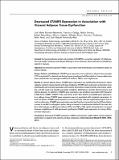Please use this identifier to cite or link to this item:
http://hdl.handle.net/10261/40602Share/Export:
 SHARE SHARE
 CORE
BASE CORE
BASE
|
|
| Visualizar otros formatos: MARC | Dublin Core | RDF | ORE | MODS | METS | DIDL | DATACITE | |

| Title: | Decreased STAMP2 expression in association with visceral adipose tissue dysfunction |
Authors: | Moreno-Navarrete, José Maria; Ortega, Francisco J.; Pérez-Pérez, Rafael CSIC ORCID; Ricart, Wifredo; Peral, Belén CSIC ORCID; Fernández-Real, José M. | Keywords: | STAMP2 Human obesity Gene expression Type 2 diabetes |
Issue Date: | 17-Aug-2011 | Publisher: | Endocrine Society | Citation: | Journal of Clinical Endocrinology and Metabolism 96(11): E1816-E1825 (2011) | Abstract: | [Context]: Six-transmembrane protein of prostate 2 (STAMP2) is a counter-regulator of inflammation and insulin resistance according to findings in mice. However, there have been contradictory reports in humans. [Objective]: We aimed to explore STAMP2 in association with inflammatory and metabolic status of human obesity. [Design, Patients, and Methods]: STAMP2 gene expression was analyzed in adipose tissue samples (171 visceral and 67 sc depots) and during human preadipocyte differentiation. Human adipocytes were treated with macrophage-conditioned medium, TNF-α, and rosiglitazone. [Results]: In visceral adipose tissue, STAMP2 gene expression was significantly decreased in obese subjects, mainly in obese subjects with type 2 diabetes. STAMP2 gene expression and protein were significantly and inversely associated with obesity phenotype measures (body mass index, waist, hip, and fat mass) and obesity-associated metabolic disturbances (systolic blood pressure and fasting glucose). In addition, STAMP2 gene expression was positively associated with lipogenic (FASN, ACC1, SREBP1, THRSP14, TRα, and TRα1), CAV1, IRS1, GLUT4, and CD206 gene expression. In sc adipose tissue, STAMP2 gene expression was not associated with metabolic parameters. In both fat depots, STAMP2 gene expression in stromovascular cells was significantly higher than in mature adipocytes. STAMP2 gene expression was significantly increased during the differentiation process in parallel to adipogenic genes, being increased in preadipocytes derived from lean subjects. Macrophage-conditioned medium (25%) and TNF-α (100 ng/ml) administration increased whereas rosiglitazone (2 μM) decreased significantly STAMP2 gene expression in human differentiated adipocytes. [Conclusions]: Decreased STAMP2 expression (mRNA and protein) might reflect visceral adipose dysfunction in subjects with obesity and type 2 diabetes. | Description: | 10 páginas, 6 figuras, 2 tablas.-- et al. | Publisher version (URL): | http://dx.doi.org/10.1210/jc.2011-0310 | URI: | http://hdl.handle.net/10261/40602 | DOI: | 10.1210/jc.2011-0310 | ISSN: | 0021-972X | E-ISSN: | 1945-7197 |
| Appears in Collections: | (IIBM) Artículos |
Files in This Item:
| File | Description | Size | Format | |
|---|---|---|---|---|
| JClinEndocrinolMetab_2011_Aug_17.pdf | 248,7 kB | Adobe PDF |  View/Open |
CORE Recommender
SCOPUSTM
Citations
31
checked on Apr 3, 2024
WEB OF SCIENCETM
Citations
31
checked on Feb 14, 2024
Page view(s)
376
checked on Apr 18, 2024
Download(s)
284
checked on Apr 18, 2024
Google ScholarTM
Check
Altmetric
Altmetric
WARNING: Items in Digital.CSIC are protected by copyright, with all rights reserved, unless otherwise indicated.
